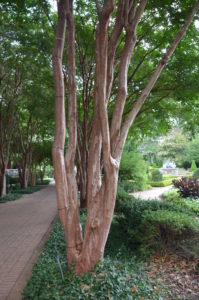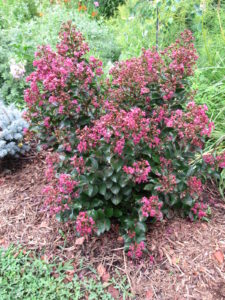If you live in zone 7 and points southward, you are likely growing crape myrtles (Lagerstroemia indica x fauriei). Additional hybrid cultivars (varieties) are hardy in zone 6. Crape myrtles are loved for their spectacular summer flowers, colorful fall foliage, and exquisite peeling bark over trunks and branches. Cultivars range in size from dwarf selections that grow less than 5 feet tall to several that reach upwards of 30 feet plus. Know the mature height of the cultivar before you purchase it.
Landscape uses: Planted several together to create a large deciduous hedge or privacy screen; utilize low shrub types in the front foundation. Plant 1-3 specimen trees as a distinctive focal point near the patio. Select the right size for your needs. Larger types should not grow into power lines. Medium-size cultivars (12 to 15 feet) are a perfect choice in a narrow side yard or a small urban garden. Dwarf selections are suited for large containers in zone 7 and points south.
Dwarf (less than 5 feet height) – ‘Cherry Dazzle’, ‘Berry Dazzle’, ‘Chickasaw’, ‘Centennial’, ‘Victor’
Semi-dwarf (5-12 feet) – ‘Hopi’, ‘Zuni’, ‘Tonto’, ‘Caddo’
Intermediate (13-20 feet) – ‘Acoma’, ‘Lipan’, ‘Osage’, ‘Sioux’
Tree type (21-33 feet) – ‘Muskogee’, ‘Apalachee’, ‘Tuskegee’, ‘Natchez’
Crape myrtles perform best in full sun and are not finicky regarding type of soil, as long as it’s well drained. Soil pH may be acidic to mildly alkaline. Keep them properly mulched and irrigated over the first summer. Feed crape myrtles with granular 10-10-10 or equivalent in early spring just before budbreak. Young trees benefit from one additional feeding in early summer. Do not fertilizer crape myrtles after mid- August. Mature trees do not benefit from annual fertilizing and frequently draw off adequate nutrition from a nearby lawn area that has been fertilized.



 Posted in
Posted in 
